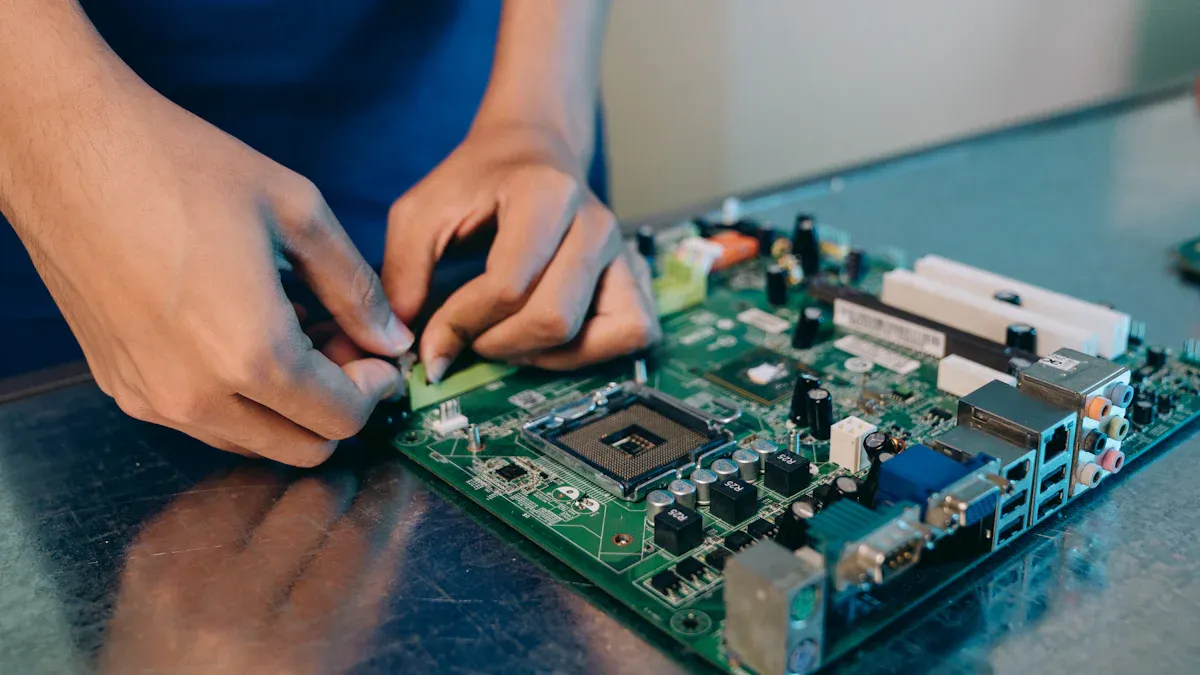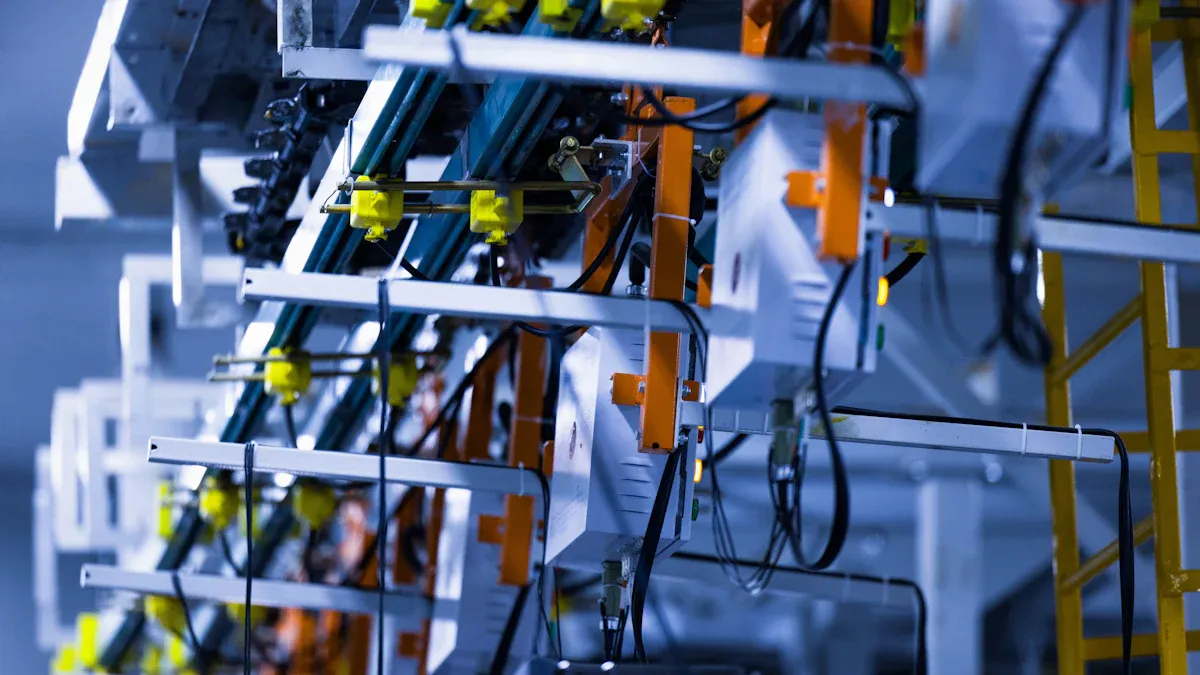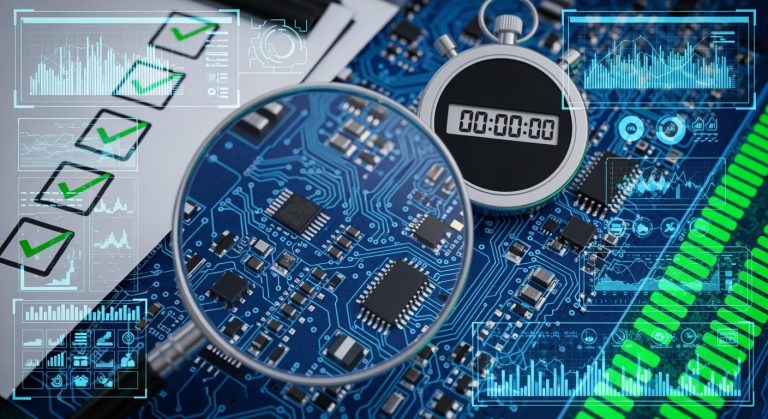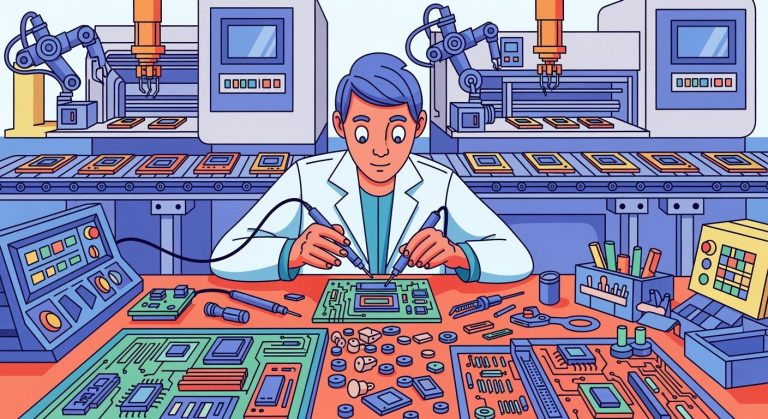How PCB Assembly Services Work and Why They Matter for Businesses
Printed circuit board (PCB) assembly is key to making electronics today. It turns plain circuit boards into working devices by adding parts like resistors, capacitors, and microchips. This process makes sure electronic circuits work correctly in things like phones and medical tools.
PCB assembly services are very helpful for businesses. Companies have seen big improvements in speed and quality. For example:
- A phone company increased daily production from 10,000 to 85,000 units and lowered mistakes to just 0.02%.
- A car parts supplier reached a 99.7% success rate, reducing warranty claims by 83%.
- Some manufacturers cut labor costs by 78% and energy use by 42% per unit.
These results show how PCB assembly boosts productivity, saves money, and improves product quality. Using these services can help your business stay strong in a changing market.
Key Takeaways
- PCB assembly turns simple boards into working devices by adding parts. This ensures electronics work well and last longer.
- Using PCB assembly services can make production faster and better. It helps businesses save money and avoid mistakes.
- Picking the right assembly method, like SMT or THT, depends on how the product is made and used. This affects how well it works.
- Checking quality and certifications is important when choosing a PCB service. It ensures good standards and reliable products.
- Good customer support from PCB services helps projects succeed. They fix problems fast and keep communication clear.
The PCB Assembly Process
Overview of PCB Assembly
PCB assembly changes plain boards into working electronic devices. It adds parts like resistors, capacitors, and microchips. This makes sure circuits work properly in gadgets, medical tools, or machines. The process needs accuracy and follows strict rules to ensure quality.
To keep the process reliable, certain standards are followed:
- IPC-A-610: Rules for soldering in PCB assembly.
- ISO Quality Management: Ensures steady performance.
- AS9100D: Quality rules for military and aerospace.
- IPC-A-600: Guidelines for checking PCBs.
- IPC 6012 CLASS 2: Standards for Class 2 PCBs.
- UL Certification – Rigid PCBs: Approval for rigid PCBs.
- RoHS / REACH Compliance: Follows eco-friendly rules.
Following these rules ensures top-quality PCB assembly.
SMT, THT, and Hybrid Methods
There are three main ways to assemble PCBs: SMT, THT, and hybrid methods. Each has its own uses and benefits.
- Surface Mount Technology (SMT):
SMT is the most common method today. Parts are placed directly on the board without drilling holes. It works well for small devices like phones and smartwatches. - Through-Hole Technology (THT):
THT uses drilled holes to attach parts. This method makes strong connections, perfect for cars and airplanes. - Hybrid Methods:
Hybrid combines SMT and THT. It uses SMT for small parts and THT for bigger ones. This is useful for complex devices like medical machines.
The choice depends on the product’s design and purpose.
Key Steps: Design, Assembly, and Testing
PCB assembly has three main steps: design, assembly, and testing. Each step is important for making a good product.
- Design:
Engineers plan the board layout using special software. A good design reduces mistakes and speeds up assembly. - Assembly:
Machines place parts on the board using SMT, THT, or both. Automated tools make the process fast and accurate. - Testing:
Testing checks if the board works correctly. Machines test for safety and function. Problems are fixed early to avoid future issues.
By following these steps, you can make high-quality PCBs efficiently.
Benefits of PCB Assembly for Businesses
Saving Money and Using Resources Wisely
PCB assembly helps businesses save money in smart ways. Automated machines lower the need for workers and reduce mistakes. This cuts costs and keeps the quality steady for every batch.
When you outsource assembly, experts handle the hard parts. This lets you focus on your main business tasks. Also, buying parts in bulk through assembly companies can save even more money. For example, using surface mount technology (SMT) skips drilling holes, saving time and materials.
Using resources well is also important. Machines use materials carefully, cutting waste and saving energy. This eco-friendly method helps your business meet green standards while keeping quality high.
Better Product Quality and Dependability
Good PCBs make products work better. PCB assembly services check quality at every step, from design to testing. SMT places parts exactly where they should be, lowering the chance of mistakes.
Testing is a big part of the process. Machines find and fix problems early, making sure each PCB meets strict rules. This creates products that work well in many areas, like gadgets or factory machines.
Strong assembly also makes products last longer. For example, through-hole technology (THT) makes tough connections, great for harsh conditions. Using reliable methods builds trust with customers and improves satisfaction.
Faster Production and Growth
PCB assembly speeds up production, helping businesses grow. Machines like pick-and-place tools work quickly and accurately. This is helpful for tight deadlines or big orders.
PCB assembly can handle complex designs and new tech. Hybrid methods mix SMT and THT to fit different parts, making it good for advanced devices. This flexibility helps you meet market needs without losing quality.
Here’s a table showing how PCB assembly boosts speed and growth:
| Performance Metric | Description |
|---|---|
| Higher Component Density | Fits more parts on the board for smaller designs. |
| Increased Speed and Efficiency | Machines work fast and accurately. |
| Reduced Manual Labor | Less handwork means fewer mistakes and faster assembly. |
| Improved Electrical Performance | Shorter connections make circuits work better. |
| Better Signal Integrity | Reduces interference for clearer signals. |
| Cost Savings | Faster work and fewer workers lower costs. |
| Higher Automation | Fully automated steps save time and improve results. |
| Better Thermal Performance | Handles heat better for hot parts. |
| Compatibility with Advanced Tech | Works with new parts and tech for modern devices. |
| Environmental Considerations | Uses less solder and energy, helping the planet. |
By using these benefits, you can produce faster and meet customer needs. This helps your business stay strong in a changing market.
Picking the Best SMT PCB Assembly Service
Choosing the right SMT PCB assembly service is very important. It helps make sure your PCBs are high-quality and your business runs smoothly. Focus on quality, skills, and clear costs to make smart choices.
Checking Quality and Certifications
Good quality is key for reliable PCB assembly. Look for manufacturers with certifications that follow industry rules. For example, ISO 9001 ensures strong quality systems. IATF 16949 is needed for car-related products. UL certification checks safety, and RoHS ensures eco-friendly practices by avoiding harmful materials.
Manufacturers should also have strong quality checks. First Article Inspection (FAI) tests a small batch to find design problems early. In-process inspections catch mistakes during production. Final inspections check if the boards are safe and work well. These steps ensure the PCBs are dependable.
| Quality Check Step | What It Does |
|---|---|
| First Article Inspection (FAI) | Tests a small batch to find design problems early. |
| In-Process Inspection | Watches production to catch mistakes as they happen. |
| Final Inspection | Checks finished PCBs for safety and proper function. |
| Certification | What It Ensures |
|---|---|
| ISO 9001 | Strong quality management systems. |
| IATF 16949 | High quality for car-related products. |
| UL Certification | Safety from electrical and fire risks. |
| RoHS Compliance | Avoids harmful materials like lead and mercury. |
Looking at Technical Skills
Technical skills are very important for picking the right service. A good manufacturer can handle tricky designs and make sure the PCBs work well. Check if they can manage things like signal clarity, signal loss, and noise issues. These affect how well the PCB works.
Some manufacturers use advanced tools like eye diagram analysis to check signal quality. This is very useful for fast devices. They should also know how to manage noise in multi-layer PCBs to avoid problems.
| Metric | What It Measures |
|---|---|
| Signal-to-Noise Ratio (SNR) | How clear the signal is compared to background noise. |
| Simultaneous Switching Noise (SSN) | Noise caused when many signals switch at the same time. |
| Insertion Loss | How much signal strength is lost while traveling through the PCB. |
| Return Loss | How much signal bounces back due to mismatched parts. |
| Eye Diagram Analysis | Shows signal quality; a wide open eye means good quality. |
Knowing Costs and Being Clear
Clear costs are important to avoid surprises. When choosing a PCB service, think about what affects the price. Things like complex parts, more PCB layers, or special machines can raise costs. For example, double-sided PCBs need more work, so they cost more.
A good manufacturer should explain all costs clearly. This includes labor, materials, and meeting quality standards like ISO 9001. Where the assembly happens also changes costs because of labor and shipping differences.
| Cost Factor | What It Means |
|---|---|
| Component Quantity and Complexity | More parts or tricky designs cost more. |
| PCB Layer Count | More layers need extra work, raising costs. |
| Specialized Equipment | Special machines may cost more for small orders. |
| Quality Standards | Meeting ISO 9001 adds costs but ensures good quality. |
| Assembly Location | Labor and shipping costs vary by location. |
By understanding these points, you can pick a service that balances cost and quality. Clear pricing helps you plan better and avoid hidden fees.
Why Customer Support Matters
Customer support is key to making your PCB assembly projects successful. You need more than just technical skills from a provider. Good support helps solve problems and keeps the process running smoothly.
A helpful support team keeps communication clear. They update you from design to testing and answer questions quickly. This avoids delays and surprise costs, keeping your work on schedule.
Support teams also fix problems. If your PCB assembly has defects or issues, they find the cause and fix it. This reduces downtime and ensures your products meet high standards.
They also guide you through tricky requirements. For example, if your project needs special tech or certifications, they ensure it meets the rules. They may suggest cheaper materials or methods to save money without losing quality.
Picking a service with great support gives you confidence. It ensures your PCB assembly is done well and helps your business stay competitive. A skilled and responsive team is like a partner, helping you succeed.
Tip: Check how fast and skilled a provider’s support team is before choosing them. Good support can greatly improve your PCB assembly projects.
Factors That Affect Cost and Reliability
Choosing Materials and Components
The materials and parts you pick for your PCB affect cost and reliability. Every choice, like the board material or type of parts, can change costs by up to 20%. It’s important to balance good performance with affordable prices.
- Buying parts costs more if they are complex or hard to find.
- Making PCBs costs depend on layers, design density, and board material.
- Assembly costs go up with tricky designs or double-sided soldering.
- Testing costs rise when using high-quality parts and materials.
| Cost Factor | What It Means |
|---|---|
| Component Choices | Picking parts affects both cost and product quality. |
| Special Requirements | Extra technical needs can make the process harder and pricier. |
| Machines Used | The tools used can change how fast and cheap production is. |
| Managing Supplies | Good planning avoids delays and saves money. |
| Quality Rules | Higher standards cost more but improve reliability. |
| Location | Where it’s made changes labor and shipping costs. |
Choosing the right materials and parts helps control costs while making sure the PCB works well.
How Automation Helps PCB Assembly
Using machines for PCB assembly lowers costs and makes products more reliable. Machines do jobs like placing parts and soldering with great accuracy. This reduces mistakes and waste, saving money and keeping quality steady.
Automation also handles tricky designs. For example, pick-and-place machines work with crowded layouts, and reflow ovens make soldering even. These tools are great for advanced tech and making lots of products quickly.
Machines also speed up production. Faster work means you can meet tight deadlines without losing quality. This is helpful for businesses that need to keep up in fast-changing markets.
Testing for Quality and Reliability
Testing is very important to make sure PCBs are reliable. Careful checks find problems early, stopping bigger issues later. Common testing methods include:
| Testing Type | What It Does |
|---|---|
| In-Circuit Testing (ICT) | Checks parts and connections while still on the board. |
| Flying Probe Testing | Uses a computer-controlled probe to test circuits quickly. |
| Automated Optical Inspection (AOI) | Uses cameras to spot problems on the board. |
| Burn-in Testing | Runs the PCB at full power for a long time to test reliability. |
| X-Ray Inspection | Uses X-rays to check inside the PCB without damaging it. |
These tests make sure every PCB meets industry rules and works well in real life. Spending on testing improves product reliability and builds customer trust.
PCB assembly services make electronics manufacturing easier and faster. They turn plain circuit boards into working products, ensuring they are reliable and can be made in large amounts. Picking the right SMT PCB assembly service improves quality and lowers mistakes. This choice helps you meet customer needs and stay competitive.
In a fast-moving market, using advanced tools and methods is important. These services improve production and keep you ahead with new ideas. Choosing dependable PCB assembly solutions helps your business grow and keeps your reputation strong.
FAQ
What is the difference between SMT and THT in PCB assembly?
SMT puts parts on the board’s surface. It works well for small designs. THT uses holes to attach parts, making stronger connections. Choose based on size, strength, and how the product will be used.
How does automated PCB assembly improve reliability?
Automation places parts and solders them with accuracy. This reduces mistakes made by people. Tools like pick-and-place machines ensure steady quality. Fewer errors mean better products that last longer.
Can PCB assembly services handle custom designs?
Yes, most services can work with custom designs. They use special tools and software to match your needs. Share your ideas clearly to get the best results.
Why is testing important in PCB assembly?
Testing finds problems early to ensure good quality. Methods like ICT and AOI check if the board works safely. This step avoids big issues and keeps customers happy.
How do I choose the right PCB assembly service?
Look for certifications like ISO 9001 and RoHS for quality. Check their skills, support, and clear pricing. A good service will meet your needs and keep high standards.





















